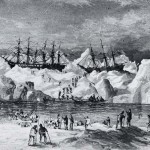When the Civil War came to Alaska
April 19, 2011
907-474-7648
from April 2011
About 150 years ago, a few days after summer solstice, the gray skies above the Diomede Islands were heavy with smoke from whaling ships set ablaze by Confederate sailors who didn't know the Civil War had ended.
"The red glare from the eight burning vessels shone far and wide over the drifting ice of these savage seas," wrote an officer aboard the Shenandoah, a ship commissioned by Confederate leaders to wreak havoc on Yankee whalers harvesting bowhead whales off the western and northern coasts of Alaska. Though their timing was off, the Civil War had been over for two months when the Shenandoah reached Alaska waters from England (after an eight-month trip around the southern capes of Africa and Australia), the captain and crew of the Shenandoah succeeded in destroying the Yankee fleet, burning 22 whaling ships and capturing two others.
"It was the last hurrah of whaling, the place where commercial whaling died in the U.S.," said Brad Barr, a biologist with the National Oceanic and Atmospheric Administration's Office of National Marine Sanctuaries in Woods Hole, Mass. Barr, NOAA historians, and archaeologists are interested in the often-overlooked history of Yankee whalers that first came to Alaska waters in 1848, finding a bonanza of bowhead whales.
Weighing 100,000 pounds each and living their entire lives in waters with sea ice, large bowheads have two feet of blubber protecting them from cold northern oceans. Whalers boiled down that fatty tissue to render about 120 barrels of oil from each whale.

A century before an exploration crew found crude oil at Prudhoe Bay, whale oil and flexible bones known as baleen were the target of whalers who set out for the Arctic from eastern ports, such as Mystic, Conn., and New Bedford, Mass.
"They took (bowheads) like they were going out of style, at least until they took too many, and the whales were harder to find and harder to catch," Barr said.
Aside from being the setting for the last shots of the Civil War fired from Confederate cannons, the waters off Alaska were the site of 32 whaling ships trapped and destroyed by sea ice in 1871.
When 12 more ships were stranded north of Barrow in 1897-1898, officials with the U.S. government commissioned a reindeer drive of 400 animals from Nome to Barrow as food for the stranded whalers, which turned out not to be needed.
"There are all of these compelling stories of heroes and villains and survival," Barr said. "Like the 32 ships trapped in the ice in 1871. Twelve-hundred-and-sixteen people had to abandon ship and drag their (smaller) whaleboats across the ice. They were rescued by seven ships that weren't caught in the ice, and brought to Honolulu."
Somewhere on the sea floor off western and northern Alaska are the waterlogged remains of those days long ago. "We've identified 160 ships lost or abandoned from 1848 to 1914," Barr said. "For the most part, nobody's been able to find them, mostly due to operational difficulties in the Chukchi and Beaufort (seas)."
This column is provided as a public service by the Geophysical Institute, University of Alaska Fairbanks, in cooperation with the UAF research community. Ned Rozell is a science writer at the institute. This column first appeared in 2008.


